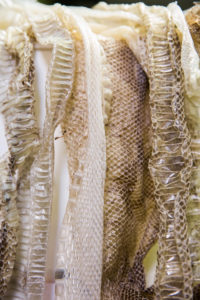
A Drexel University professor is studying snakes and their skins to better understand traction and to help engineers improve the design of textured surfaces such as engine cylinder liners, prosthetic joints and even footwear.
Hisham Abdel-Aal, Ph.D, an associate teaching professor in Drexel University’s College of Engineering, believes that snakes offer an excellent means to study friction (a science called tribology), which is his area of expertise in mechanical engineering. He has been collecting and analyzing snake skins for almost a decade in an effort to not just understand but to quantify the way snakes generate friction when they move.
In a paper recently published in the Journal of the Mechanical Behavior of Biomedical Materials, he explains how the information can be used in the design of commercial products that slip and stick: a process called “bio-inspired surface engineering.”
“Nature has informed many areas of engineering and design, but tribology is one field of study that has been somewhat overlooked when it comes to learning from nature,” said Abdel-Aal. “Snakes in particular have a lot to teach us about optimizing slip and grip. Their existence is dependent on efficiency of motion in very specific environments. The snakes we are studying today are the result of an evolutionary process that has fully adapted the micro-structure of their skin and their body structure to moving and surviving in their habitat from day one. These environments can be brutal on even our most advanced machinery, so applying what we know about snake texturing could help our technology adapt as well.”
Assembling the required information is a demanding process. With the help of research associates, Abdel-Aal mounts each snakeskin on graphing paper, scans it to make a record with a visual frame of reference, then he makes detailed measurements of the shape and size of the scales and their positioning relative to one another and about the snake’s body.
Eventually, he will examine the skin with a scanning electron microscope to produce an image of the microscopic features that create its texture. Snake scales have invisibly small, hair-like structures, called fibrils. Though they’re just a micron in length—about 1/100th the width of a human hair—the fibrils and how they are arranged on the snake’s underside are key to its ability to generate friction, he says.
Our understanding of friction has been limited, at best. Abdel-Aal suggests this is because our efforts have been focused on trying to negate it with lubricants or maximize it with texture, generally in pursuit of “on-off” goals. Once the goal is reached (making an engine piston produce a certain amount of horsepower, or a football cleat that works on a muddy field) the work that went into it doesn’t usually contribute to a broader understanding of friction. But plotting out the topographical characteristics of each snakeskin sample has helped researchers understand how each species manages friction in unique ways.
“Design of texture is still viewed as a ‘black art’ to the effect that currently there exists a gap between available enabling texturing technologies and a conceptual texture-design paradigm,” he wrote in a review of functional surfaces. A better understanding would not only improve the efficiency of these specific design challenges, but it could also inspire broader use of friction in the design of new surfaces, he says.
A guide Abdel-Aal has created makes it possible for designers to make more intentional choices in designing surfaces.
 TEXTILES.ORG
TEXTILES.ORG


